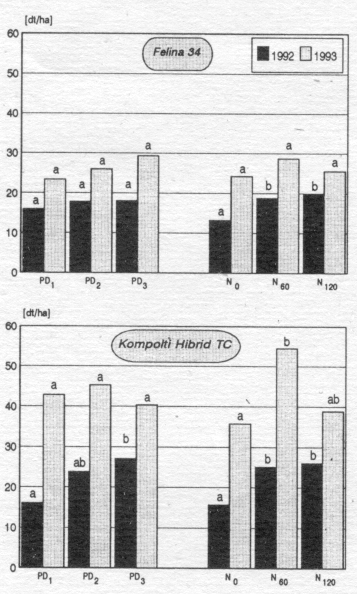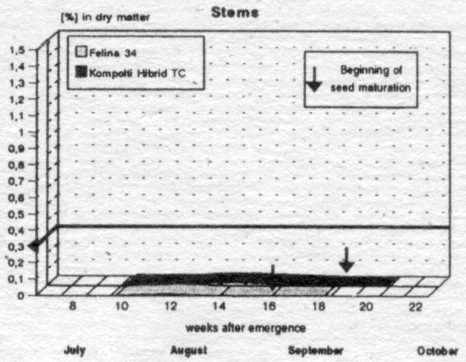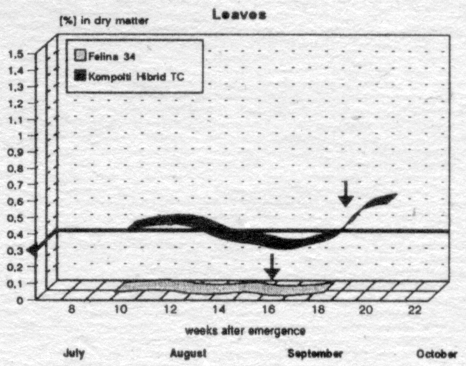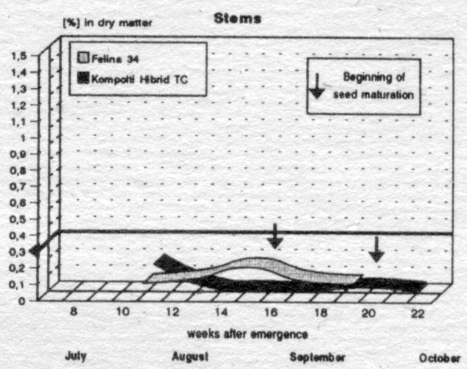
18
Cultivation experiments with
two fibre hemp varieties
F. Höppner and U. Menge-Hartmann
The influence of different population densities (150/250/350 plants/m2) and a varied nitrogen input (0/60/120 kg/ha) on the development and yield of the medium-early maturing monoecious fibre hemp variety (Cannabis sativa L.) Felina 34 and the late maturing dioecious Kompolti Hibrid TC were tested. The highest yields of dry matter and of fibre tended to be correlated (but not significantly) with the highest population density and with the highest nitrogen level. During the vegetation period the content of delta-9-tetrahydrocannabinol (THC) and of cannabidiol (CBD) of the upper third of the sensitive main stem inflorescence was analyzed, fractionated by stem, leaves and bracts of the fruits. The contents of THC increased during plant development, and the highest THC concentration was attained in the bracts during the initial fruit ripening phase.
Introduction
As an industrial
crop for the production of technically usable fibres in Germany, only flax is at present
available. In an effort to reintroduce the cultivation of industrial plants, fibre
hemp (Cannabis saliva L.) ought not to be excluded (Dambroth 1993). But in
Germany, the cultivation of hemp is generally forbidden under the narcotics law of July
28, 1981.
At the moment there are numerous public
discussions in Germany about the pros and cons of an abolition of the prohibition of the
cultivation of the industrial plant fibre hemp. However, the most important
prerequisite for a reintroduction of the cultivation of fibre hemp is the evolution of
integrated concepts of research and development (beginning with the breeding of hemp
varieties nearly free of tetrahydrocannabinol), developing economically as well as
ecologically tolerable technology for harvest and fibre extraction, and concluding with
the marketing of hemp products (Hoffmann 1961; Dambroth 1993).
The aim of the present work was to investigate
the agronomic aspects of hemp cultivation and the yield potential of modern varieties
under today's cultivation conditions.
Material and Methods
In 1992 and 1993
field trials were performed with the fibre hemp varieties Felina 34, a medium-early
maturing monoecious variety (FNCP, France; cited in the common catalogue for agricultural
plant species of the EU, 1989) and with Kompolti Hibrid TC, a late maturing dioecious F1
hybrid (Bocsa, personal communication).
The 2.5 x 26 m plots were laid out in a random
block arrangement in three replications. The soil was a loamy sand with 30 to 35
soil points. In both years, sowing took place in the middle of May with a constant
distance between the rows of 12.5 cm, a depth of deposition of 3 to 4 cm and with the
three sowing densities 150, 250 and 350 seeds/m2 corresponding to the intended population densities BD1, BD2 and BD3.
Within these population densities the nitrogen fertilization (potassium ammonium nitrate)
was varied in the three levels 'without nitrogen' (N0), 60 kg N/ha (N60) and 120 kg N/ha
(N 120). The nitrogen was applied in two doses, the first directly after sowing, the
second four weeks later.
In the test years 1992 and 1993 the total
rainfall was 613 and 686 mm respectively, (the mean of many years was 619 mm), and during
the vegetation period of hemp (May to September) 182 and 381 min respectively (the mean of
many years was 321 mm). Because of the low amount of rain in 1992, there was an
additional irrigation of 125 mm in five applications.
Seedling emergence, the number
of male and female, or rather monoecious plants, as well as the number of plants present
at the time of harvest were established on marked square meter areas.
To determine the fibre content, the hemp plants
were harvested as soon as more than half the male plants started to wither (Anon. 1962)
and the fruits of the female, or rather monoecious, plants started to mature (Bredemann
1922), meaning, 30 to 50 % of the fruits getting resistant to compressing (de Meijer et
al. 1992). For each part of the test, 25 male and 50 female, or rather monoecious
plants, representative with regard to height and stem diameter, were pulled out of the
soil by hand and the length of the stalks measured from the pitting of the cotyledons to
the top as well as the diameters in the middle of the stem (n=25). After some weeks
of air drying, the roots were cut at the pitting of the cotyledons, and fruits, leaves and
lateral stems removed. The fibre extraction was performed on these stems with
anaerobic warm water retting and boiling in 2 % aqueous sodium hydroxide as described in
Höppner and Menge-Hartmann (1994).
The determination of the yields (in dt/ha) of
stem dry matter and of fibre at the time of fibre maturity are based on the above cited
random sample harvests and a multiplication by the number of plants in the square meter
plots.
The cannabinoid analyses were performed on the
tops of the female, or rather monoecious, plants starting with the eleventh internode
segment, because in the inflorescence section the highest cannabinoid concentrations are
to be expected. During vegetative growth, starting with the tenth (1992) or eleventh
(1993) week of the growing season, 12 plants of each replication of the middle spatial
arrangement (250 plants/m2) and of
all three nitrogen levels were harvested at 14 day intervals. The tops were
separated into the fractions stems, leaves and, as far as possible, into bracts, seeds
included. The samples were dried at 30 ûC for about 10 days and stored under dark,
dry conditions until analysis. The dried bracts were separated from the seeds by
sieving. All the samples were ground in a Fritsch Pulverisette mill over a 1,0 mm
sieve. The chemical preparation and the gas chromatography (GC) analysis was carried
out according to de Meijer et al. (1992). Analyses were performed on a
Hewlett-Packard 5890 gas chromatograph with auto sampler equipped with a split-splitless
injector, a flame ionization detector and a fused silica column (25 m x 0.2 min I.D.)
coated with 5 % phenyl methyl silicon.
Analyses of variance and correlation were
carried out with the statistical procedure SAS. The comparison of the means of the
main effects to test for significance were performed with the Duncan range test, where a
probability of error of p<0.05 was based. Significant differences are represented
by different letters, separated according to variety and year.
Results and discussion
Development of plants
In both years
seedling emergence of both the varieties Felina 34 and Kompolti Hibrid TC started about
one week after sowing. At first growth was rather slow, and sprouting weeds
developed much faster. But four weeks later, in the middle of June, the hemp began a
very strong growing phase, during which a growth of 20 to 40 cm a week was realized.
During this phase weeds were so suppressed by the hemp that they died. With
the beginning of the development of flowers the hemp essentially stopped growing.
Both varieties showed differences in their
photoperiodic behavior. The monoecious Felina flowered earlier than the dioecious
Kompolti. In 1992 there were visible female inflorescences at the monoecious plants
of Felina in about the middle of July (eight weeks after seedling emergence), and at the
female plants of Kompolti in the beginning of August (ten weeks after seedling emergence).
The proportion of male plants was 8% and 27% respectively. The different
flowering behavior of the two varieties had an effect on the time of maturing. In
1992 fibre maturity was reached by Felina in August and by Kompolti in the beginning of
September. Because of the cold and humid weather in 1993, plants stayed in the
vegetative phase longer and the initiation of flowering was delayed for about two weeks.
In 1993, at the time of fibre maturity in all
the variants the stems of the female plants of Kompolti had a mean length of 247 cm, about
50 cm longer than 1992 (191 cm), whereas the height of the monoecious plants of Felina was
191 cm (1993) and 169 cm (1992). They were surpassed by the male plants in the mean
of all the variants with 40 cm of Felina and 50 cm of Kompolti in 1993 (not recorded in
1992). Obviously the higher precipitation of 1993 in comparison to 1992 had a
positive effect on the technical stem length, especially in the variety Kompolti.
However, the stem length essentially depends on the period of the vegetative phase, so
that plants of late maturing hemp varieties, as for example Kompolti, generally grow
longer than the ones of earlier maturing varieties, such as Felina e.g. (Heuser 1927;
Hoffmann 1961).
Spatial arrangement
The spatial
arrangements of 150, 250 and 350 plants/m2 were only partially reached (Table 1). The higher the strived for spatial
arrangement, the greater the variance from the actually realized spatial arrangement,
especially in 1992. In contrast, the three spatial arrangements in 1993 were mostly
better realized, because of higher sowing densities. In both years seedling
emergence generally was higher in Felina, partially based on a somewhat higher germination
capacity. The reduction of the spatial arrangement until harvesting was very strong
because of the competition among the hemp plants, especially in 1993. Generally the
reduction increased with a greater strived for spatial arrangement and with increasing
nitrogen fertilization levels.
A reduction in the number of hemp plants per
unit area during the development of the population was already described in literature.
According to reports from Germany, Italy, The Netherlands and England, the density
of plants shortly after seedling emergence is at least is twice as high as at harvest
(Heuser 1927, Hoffmann 1961, Rivoira et al. 1975, van der Werf 1991, Low 1994). Weak
plants are suppressed, die, or form the so-called "Unterhanf" (Hoffmann 1961).
A reduction of the difference between starting and concluding stand could possibly
be controlled with more homogeneous environmental conditions during sprouting and early
development (van der Werf 1991) as well as by a higher vitality of the seedlings, so that
as many as possible of the plants reach the mean height of the stand (Hoffmann 1961).
Fibre Content
With 19 to 25.8%
pure fibre content (the breadth of male and female plants), Kompolti achieved higher
values than those of Felina (17.3 to 22.8%), and the male plants in both cases had higher
contents than the female or monoecious plants (Table 2). The population density
showed no significant influence on the fibre content, although generally the fibre
contents in mid-sized populations were highest. This was not clearly evident in male
plants. Other authors have determined an increase in fibre content with increased
population density (van der Werf 1991). This was possibly due to minimal secondary
stem thickness growth with increased plant density. Very high nitrogen levels had a
negative impact on all of the plants, which had already been observed by Aukema et al.
(1957). Between the test years, no significant difference in the fibre content of
Felina could be established. In Kompolti, the 1993 contents were significant in
female plants, but only minimally higher in the male plants. Generally higher fibre
contents are found in male plants of both varieties.
In fibre content data, a distinction must be
made between the generally used term "retting fibre content" and "pure
fibre content." Bredemann (1922, 1942) calls the fibres won through the
processes used here "pure fibres," because they are macerated, very pure, and
contain a certain level of individual fibres. The yield of technically retted fibres
is naturally higher than the pure fibre content. Through multiplication with the
correction factor 1.3, the expected retted fibre yield can be calculated from the pure
fibre content. In his breeding experiments (1922 to 1953), Bredemann found
Elite-female plants with up to 31.8% pure fibre. Recently, Elite plants were found
with 37% pure fibre; and in Hungary, the fibre content of one Kompolti variety was 34.8%,
which would yield 40% in technically retted fibre (Hoffmann et al. 1970).
Area-determined Dry Matter and Fibre Yields
The highest dry
matter yields in monoecious or female plants were found in Felina, with a mean of 105.1
dt/ha (1992) and 138 dt/ha (1993) in the highest density populations (Figure 1).
Differences were seen in Kompolti in the test years. In 1992, the highest mean
yields were in the highest density populations (137.5 dt/ha). In 1993, the levels in
middle-density populations were adequate (168.6 dt/ha). In any case, there was no
meaningful difference noted between Population Density 2 and Population Density 3 in 1993
in the number of plants reaching maturity (Table 1). Similar tendencies were found
in the fibre yields (Figure 2). High dry matter and fibre yields were found in both
varieties in both years because of nitrogen fertilizer in the amounts of 60 and 120 kg
N/ha. It was shown that the highest nitrogen levels no longer had a significant
effect on the yield (Figure 1 and 2). The strong yield losses in the plants
fertilized with higher levels of nitrogen seen between 1992 and 1993 can be traced back to
the high reduction in plant numbers between their emergence and harvest in 1993 (Table 1).
In Dutch studies, the optimal population density is lower, 90 plants/m2, and the nitrogen level higher, with a total
quantity of 170 kg N/ha (fertilizer and soil nitrogen); and an optimal stem dry matter
yield of 8 to 16 t/ha was found (van der Werf 1994).
Male plants, especially the Kompolti, have an
important impact on yield performance. At the time point when the plants reach
optimal fibre maturity, a high percentage of male plants in all plant populations in all
varieties showed dry mass yields of 30.6 (1992) and 77.6 (1993) dt/ha as well as fibre
yields of 7.3 and 19.2 dt/ha.

Figure 1: Dry matter yield of monoecious or dioecious stems of Felina 34 and Kompolti Hibrid TC

Figure 2: Fibre yield of monoecious or dioecious stems of Felina 34 and Kompolti Hibrid TC
Content of delta-9-tetrahydrocannabinol (THC)
In 1992 and 1993
the content of delta-9-tetrahydrocannabinol (THC) of both varieties increased in the three
investigated plant parts stem, leaves and bracts of the inflorescences in the mean of all
variants at the time of fruit development (Figures 3 and 4). After that stage the
values decreased more or less quickly. Generally the maximum THC content in the
leaves and bracts especially was reached during initial fruit maturity. A similar
course in the development of the THC content was observed by Hai (1984) and by Kessler
(1984). High THC contents also occurred with the initiation of flower development,
then at first they decreased again, however. The highest THC concentrations of all
investigated plant parts in both varieties were reached by the bracts. On the bracts
the density of the glandular hairs, the sticky resins of which contain the cannabinoids,
is the highest (Pate 1994). The maximum THC content in the bracts of Felina was 0.16
% (1992) and 0.2 % (1993) respectively and of Kompolti 1.06 % (1992) and 1.41 % (1993)
respectively. The maximum contents of the leaves were somewhat lower. The THC
contents of the stems nearly in all cases were below 0.03 %. Only in 1993 the stem
values of Felina were higher for unknown reasons.



1992
Figure 3: Development of THC content in the dry matter of stems, leaves and bracts of Felina 34 and Kompolti Hibrid TC during vegetation period in 1992



1993
Figure 4: Development of THC content in the dry matter of stems, leaves and bracts of Felina 34 and Kompolti Hibrid TC during vegetation period in 1993
Between the
varieties there were clear differences both in the maximum THC contents and in the course
of the development of the THC content. In view of the within the European Unity
maximum tolerated content of 0.3 % THC in fibre hemp varieties there was to be seen, that
all plant tops of Felina clearly fell below this value during the complete vegetation
period of both years. On the other hand the THC contents of the leaves and bracts
of Kompolti nearly always were higher than 0.3 %. The ascending section of the curve
of the THC content development from Felina was only very weakly revealed in comparison to
Kompolti. Maximum THC contents were already attained in the middle to end of August
by Felina, and by Kompolti only in the middle to end of September, what can be put down to
the fact of temporal differences in the development of flowers and fruits of the two
varieties.
In comparison of the two test years it was
shown, that in 1993 higher THC contents were attained. Obviously, the continuously
good water supply due to regular precipitation in 1993 had a positive effect on the THC
content. The year 1992 was very dry in summer, and the plants could not always be
sufficiently supplied with water in time, in spite of additional irrigation.
In 1993 a delayed phase of flower development
of both varieties was the reason for the maximum THC contents postponed during the
vegetation period, the time shift being stronger of Kompolti.
Conclusions
For the
practical cultivation of fibre hemp a nitrogen fertilization of 60 to 100 kg/ha should
completely be sufficient after our experimental results. The choice of the optimal
spatial arrangement depends on the variety. A variety with a strong growth and a
long vegetation period like Kompolti Hibrid TC used here, calls for a lower sowing density
in comparison to the smaller and earlier maturing variety Felina 34. Because of the
dense and quick growth of the plants no weed control is necessary.
The highest THC contents are to be expected
during initial fruit maturity at the time of fibre ripeness. This process is
influenced by the weather with regard to both the time of the temporal appearance and the
height of the content. In varieties with already low THC contents, as e.g. the
variety Felina, the increase in THC content during the vegetation period is only
insignificant. The flowering period THC content also remains relatively constant,
compared with higher THC varieties such as Kompolti.
References